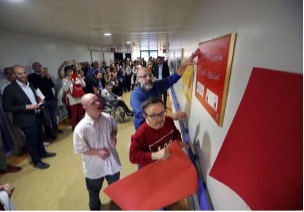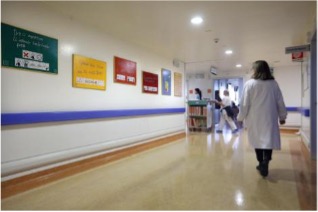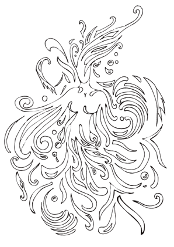When we live a traumatic experience, it remains imprinted in our brain and is not always accessible cognitively and through language. Art therapy can be a tool to help us get in touch with these remote parts of our mind and to be able to ‘narrate’ the trauma in a constructive and protected way with a view to recovery.
The techniques and methods used to assist people in expressing themselves in an artistic and alternative way are different, ranging from the use of colours to the manipulation of materials; artistic skills are not required, but the willingness to accept a different proposal to express oneself and to be followed by a person with the relevant skills. Art therapy is a tool to support the caregiver and a valuable opportunity for the patient to foster the development of his or her personality and gain self-awareness.
The project “art in the places of care” was born within the framework of a training course called DNA, created by the Health and Care Area in partnership with the Hollister/Dansac company and aimed at over 20 stoma nurses from all over Italy.
The aim of this initiative, which was strongly supported by this group of stomatherapists, was to introduce art into places of care, in particular for people who have suffered the trauma of having an ostomy performed, i.e. a surgical intervention on the intestine or urinary tract, changing the appearance of their body.
From an operational point of view, work was carried out on two levels: on the one hand, the spaces of the hospital have been made more welcoming through the presence of the beauty of art (aesthetic dimension); on the other hand, work was carried out to allow people with ostomy, especially in the most difficult phase of managing the trauma, to express themselves through artistic expression (educational dimension), exploiting the self-reflective and self-formative value of this practice, contributing to giving meaning and significance to what is happening.
As far as spaces are concerned, an “art gallery” was set up in the Surgical Ward of the Maggiore Hospital in Bologna, with works created by guests with disabilities from the L’Arche community in Quarto Inferiore (BO) under the expert guidance of painter Rita Mangano (ISTUD). Seven paintings, as many as the colours of the rainbow, each with a message addressed to those who live the experience of ostomy, through the use of colour and Alternative Augmentative Communication, a mode of expression to support those who can not express themselves through traditional channels of communication. A project with a strong artistic and social value, where the beauty went beyond the aesthetics of the installation and focused more on the energy and emotional dynamics that it generated in the people who created the work and in those who benefit from it as they walk through the corridors of the surgery ward.


As far as self-expression through art therapy is concerned, the ASST Fatebenefratelli Sacco and the Policlinico di Milano Ospedale Maggiore were involved. Starting from the real narratives of people with ostomy collected in these two hospitals, a “alternanza scuola-lavoro” project was launched with a class from the Liceo Artistico U. Boccioni in Milan to let the students know what the ostomy experience consists of, and give them the opportunity to be inspired and create sketches and representations to be given to people with ostomy in order to enable them to practise art therapy.
The works created by these students were collected in a volume, giving life to a real publishing project, called “COOL Colours”.
This initiative has had multiple purposes: to give people with ostomy surgery the possibility of benefiting from a different expressive modality (colour, drawing) in order to help alleviate a particularly difficult moment in their treatment pathway; to allow the high school students to approach and understand the experiences of illness and at the same time to put their artistic skills into practice for the realisation of a concrete work on commission; to give the hospital companies the possibility of providing their patients with a new tool which is the result of the collaboration between the school and the hospital.

Here are the voices of some people who have had the opportunity to express themselves through art therapy:
“Colouring calms me down, it helps me think positively”
“It has allowed me not to think, to do something without any purpose, but only for the pleasure of doing it”
“I realised that when I finished colouring I felt relaxed and less stressed”.
The book, which was presented on 27 May, will be distributed in the main Italian hospitals to people with ostomy, giving them the opportunity to indulge in art therapy practices through the use of colours and drawing.
